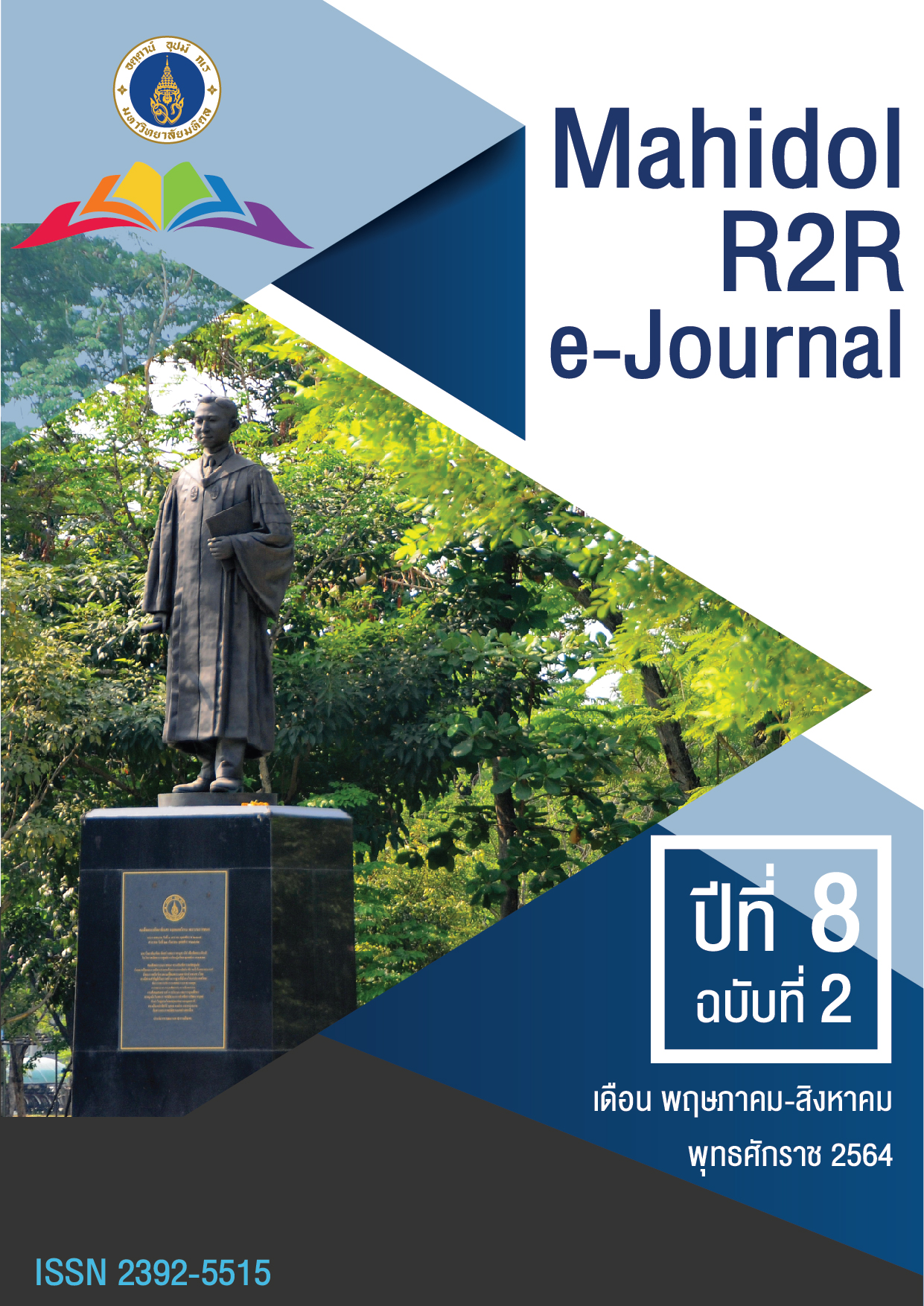ขนาดของ LVOT ในเด็กทารกแรกเกิดที่คลอดก่อนกำหนด
DOI:
https://doi.org/10.14456/jmu.2021.21คำสำคัญ:
ขนาด LVOT, เด็กแรกเกิดคลอดก่อนกำหนด, การตรวจคลื่นเสียงสะท้อนหัวใจบทคัดย่อ
เด็กทารกแรกเกิดที่คลอดก่อนกำหนดเป็นภาวะที่กายวิภาคและสรีรวิทยาของระบบหัวใจและหลอดเลือดในร่างกายยังไม่สมบูรณ์การเทียบขนาดอวัยวะของเด็กคลอดก่อนกำหนดด้วยเกณฑ์ของเด็กที่คลอดครบกำหนดเพื่อวินิจฉัยความผิดปกติจึงอาจมีข้อจำกัดแม้แต่ขนาด Left ventricular out flow tract; LVOT ที่เป็น Echocardiographic parameter สำคัญก็เช่นกัน เพราะการอธิบายความผิดปกติของขนาดของหลอดเลือด และระดับความรุนแรงของรอยโรคบางชนิดจำเป็นต้องใช้ขนาดของ LVOT มาคำนวณ แต่เนื่องจากผลการศึกษาเกี่ยวกับขนาด LVOT ในเด็กคลอดก่อนกำหนดชาวไทยและชาวเอเชียนั้นยังมีไม่หลากหลาย ส่วนใหญ่ใช้ค่า Z score ของประชากรตะวันตกมาใช้อ้างอิงเป็นหลัก จึงเกิดการศึกษาวิจัยนี้ขึ้น โดยอาศัยการทบทวนผลตรวจคลื่นเสียงสะท้อนหัวใจของทารกคลอดก่อนกำหนดชาวไทยทั้งสิ้น 102 ราย อายุไม่เกิน 4 สัปดาห์ เพศชาย ร้อยละ 53.9 เพศหญิงร้อยละ 46.1 ไม่มีพยาธิสภาพชนิดที่ส่งผลต่อโครงสร้างของหัวใจและหลอดเลือด พบว่าเด็กแรกเกิดชาวไทยเพศชายกับเพศหญิงมีขนาด LVOT ไม่แตกต่างกัน แต่ผู้ป่วยที่มีน้ำหนักเฉลี่ยมากกว่า 1,400 กรัม จะมีขนาด LVOT ที่ใหญ่กว่ากลุ่มที่มีน้ำหนักน้อยกว่า 1,400 กรัม อย่างมีนัยสำคัญทางสถิติ (P value < 0.05) โดยที่ระดับ Z score 0-0.5 กลุ่มที่มีน้ำหนักน้อยกว่า 1,400 กรัมจะมีขนาด LVOT 5.10 – 5.50 มิลลิเมตร ส่วนกลุ่มน้ำหนัก 1,400 กรัมขึ้นไป จะมีขนาด LVOT 5.50 – 5.70 มิลลิเมตร ในจำนวนนี้มี 60 ราย ที่ถูกติดตามเพื่อเปรียบเทียบขนาด LVOT ในระยะ Patent ductus arteriosus กับระยะ Ductus arteriosus closed แต่ไม่พบความแตกต่างกันของขนาด LVOT ในทั้งสองระยะ ซึ่งข้อมูลเหล่านี้เป็นองค์ความรู้สำคัญที่สนับสนุนและเป็นตัวเลือกให้ผู้ตรวจวัดสามารถเลือกนำค่าปกติไปใช้เทียบแปลผลในเด็กไทยได้สะดวกเพิ่มประสิทธิภาพการทำงานได้อีกทาง
เอกสารอ้างอิง
Aritonang, E., Rajagukguk, T., & Nasution, E. (2015). Analysis of Body Weight in Low Birth Weight Infant Based on Breastfeeding and Formula Milk for Two Weeks Nursing in Santa Elisabeth Hospital Medan. International Journal of Sciences. 23(1), 308-317
Arlettaz, R. (2017). Echocardiographic evaluation of patent ductus arteriosus in preterm infants. Frontiers in pediatrics, 5, 147.
Chubb, H., & Simpson, J. M. (2012). The use of Z-scores in paediatric cardiology. Annals of pediatric cardiology, 5(2), 179.
Eisenberg, E., Vlismas, P., Spinetto, P. V., & Spevack, D. (2016). SUBSTITUTION OF LEFT VENTRICULAR OUTFLOW TRACT DIAMETER WITH BODY SURFACE AREA. Journal of the American College of Cardiology, 67(13 Supplement), 1783.
Gutgesell, H. P., & Rembold, C. M. (1990). Growth of the human heart relative to body surface area. The American journal of cardiology, 65(9), 662-668.
Harris, P., & Kuppurao, L. (2015). Quantitative Doppler echocardiography. Bja Education, 16(2), 46-52.
Kampmann, C., Wiethoff, C., Wenzel, A., Stolz, G., Betancor, M., Wippermann, C., . . . Emschermann, T. (2000). Normal values of M mode echocardiographic measurements of more than 2000 healthy infants and children in central Europe. Heart, 83(6), 667-672.
Leye, M., Brochet, E., Lepage, L., Cueff, C., Boutron, I., Detaint, D., . . . Messika-Zeitoun, D. (2009). Size-adjusted left ventricular outflow tract diameter reference values: a safeguard for the evaluation of the severity of aortic stenosis. Journal of the American Society of Echocardiography, 22(5), 445-451.
Mertens, L., Seri, I., Marek, J., Arlettaz, R., Barker, P., McNamara, P., Simpson, J. (2011). Targeted neonatal echocardiography in the neonatal intensive care unit: practice guidelines and recommendations for training: Writing group of the American Society of Echocardiography (ASE) in collaboration with the European Association of Echocardiography (EAE) and the Association for European Pediatric Cardiologists (AEPC). European Journal of Echocardiography, 12(10), 715-736.
Pettersen, M. D., Du, W., Skeens, M. E., & Humes, R. A. (2008). Regression equations for calculation of z scores of cardiac structures in a large cohort of healthy infants, children, and adolescents: an echocardiographic study. Journal of the American Society of Echocardiography, 21(8), 922-934.
Porter, T. R., Shillcutt, S. K., Adams, M. S., Desjardins, G., Glas, K. E., Olson, J. J., & Troughton, R. W. (2015). Guidelines for the use of echocardiography as a monitor for therapeutic intervention in adults: a report from the American Society of Echocardiography. Journal of the American Society of Echocardiography, 28(1), 40-56.
Skelton, R., Gill, A., & Parsons, J. (1998). Reference ranges for cardiac dimensions and blood flow velocity in preterm infants. Heart, 80(3), 281-285.
Tacy, T. A., Vermilion, R. P., & Ludomirsky, A. (1995). Range of normal valve annulus size in neonates. The American journal of cardiology, 75(7), 541-543.
Van Ark, A. E., Molenschot, M. C., Wesseling, M. H., de Vries, W. B., Strengers, J. L., Adams, A., & Breur, J. M. (2018). Cardiac Valve Annulus Diameters in Extremely Preterm Infants: A Cross-Sectional Echocardiographic Study. Neonatology, 114, 198-204.
Walther, F. J., Siassi, B., King, J., & Wu, P. Y. (1985). Normal values of aortic root measurements in neonates. Pediatric cardiology, 6(2), 61-63.
ดาวน์โหลด
เผยแพร่แล้ว
ฉบับ
ประเภทบทความ
สัญญาอนุญาต




